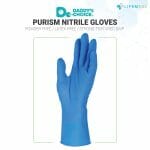What is Bloodborne Pathogen PPE?
Bloodborne Pathogen PPE (Personal Protective Equipment) refers to specialized protective gear designed to safeguard individuals from exposure to bloodborne pathogens, which are infectious microorganisms found in blood that can cause diseases such as hepatitis B, hepatitis C, and HIV. This type of PPE is essential in environments where employees may come into contact with blood or other potentially infectious materials (OPIM). Bloodborne Pathogen PPE includes items such as gloves, face shields, gowns, masks, and eye protection, all of which create barriers that prevent pathogens from entering the body through skin, eyes, nose, or mouth.
This PPE is crucial in healthcare settings, laboratories, emergency response, and any industry where there is a risk of exposure to blood or bodily fluids.
Importance of Bloodborne Pathogen PPE in the Enterprise Environment
In industries such as healthcare, dentistry, emergency response, and laboratory work, employees are at risk of exposure to infectious bloodborne pathogens. Bloodborne Pathogen PPE plays a critical role in protecting workers from these hazards, ensuring that they have a physical barrier that prevents direct contact with blood or infectious materials. Proper use of PPE reduces the risk of workplace illnesses and infections, ensuring the safety and well-being of employees.
For enterprises, providing bloodborne pathogen PPE is also essential for compliance with regulations such as OSHA’s Bloodborne Pathogens Standard (29 CFR 1910.1030). This regulation mandates that employers must provide appropriate PPE to workers who are exposed to bloodborne pathogens, as well as training on its proper use. Non-compliance with this regulation can lead to significant fines, legal liabilities, and increased risk of workplace infections.
Moreover, PPE management for bloodborne pathogen protection is critical in maintaining a safe work environment. Workers who feel secure in their protective gear are more likely to handle biohazardous materials safely, leading to fewer incidents of exposure and maintaining operational efficiency in high-risk environments.
Types of Bloodborne Pathogen PPE
1. Gloves
- Purpose: Provides a barrier to protect hands from contact with blood and other fluids.
- Common Uses: Healthcare, laboratories, and emergency services.
2. Face Shields and Masks
- Purpose: Protects the face, eyes, nose, and mouth from blood splashes and droplets.
- Common Uses: Ideal for medical procedures, dental work, and surgeries.
3. Gowns and Aprons
- Purpose: Shields clothing and skin from exposure to blood and bodily fluids.
- Common Uses: Commonly used in hospitals, clinics, and research labs.
Managing Bloodborne Pathogen PPE with Enterprise Software
Enterprise software can streamline the management of Bloodborne Pathogen PPE by automating inventory tracking, compliance monitoring, and usage reporting. Key features include:
- Inventory Management: Track and monitor PPE availability to ensure workers are equipped with necessary protective gear.
- Compliance Monitoring: Ensure that PPE use meets OSHA standards and other relevant regulations.
- Training and Documentation: Track employee training on the proper use of Bloodborne Pathogen PPE.
Conclusion
Bloodborne Pathogen PPE is a critical component of workplace safety in environments where exposure to infectious materials is a risk. Ensuring the proper use and management of this protective gear not only protects employees but also keeps businesses compliant with safety regulations. Enterprise software helps optimize PPE management, ensuring that workers are properly equipped, trained, and protected from bloodborne hazards.
« Back to Glossary Index

















